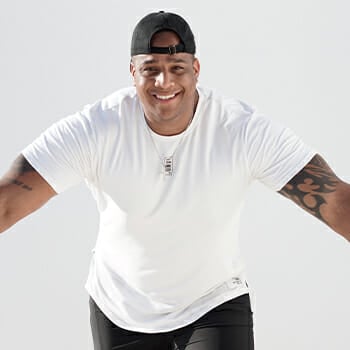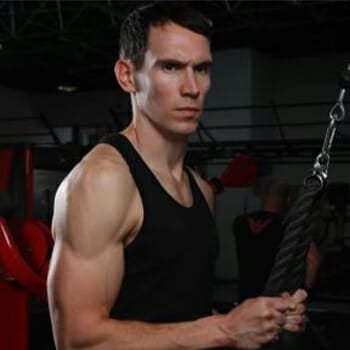During my career as a personal fitness trainer, I came across a hundred different opinions about how often we really need to exercise.
Some argue that two times a week is enough, while other experts and athletes say it takes six times to see optimal results. My clients and exercisers are often unsure of what to believe, so I decided to consult with my colleagues, fitness trainers, top athletes, nutrition specialists, and owners of popular fitness blogs.
In this article, you will find their opinions on how often an individual should exercise, tips for achieving better shape and healthy nutrition, and much more.
1. Daniel Maman

Daniel Maman is the co-founder and Marketing Director of My Phenom Fitness, a website that seeks to be a top source for information on fitness, nutrition, and home gym equipment.
As a personal trainer, Maman knows there is no one-size-fits-all solution to everybody’s workout needs.
How often you should workout and the intensity of your sessions would depend on your goals and where you are in your fitness journey.
He says you should hit each muscle group two to three times a week, to maximize gains which you can do in various splits.
If you’re doing a full-body split, working out three times a week will give you significant gains, as full-body workouts enhance the release of the insulin-like growth factor (IGF) growth hormone and testosterone.
If you prefer a three-day split, working out six days a week will allow you to hit each muscle group twice a week.
There are also four and five-day splits, but they should be reserved for advanced bodybuilders who need to overload their muscles to maximize gains.
For weight loss, going on a calorie deficit is a must. Maman recommends working out five to six times a week, depending on your endurance. If you’re simply looking to maintain your figure and you have a solid diet, working out twice a week is enough. Otherwise, if you’re in a caloric surplus, you might have to work out more.
2. TJ Mentus
TJ Mentus is a Functional Range Conditioning Mobility Specialist who has been an ACE Certified Personal Trainer for 6 years. He is also a member of the expert review board at Garage Gym Reviews.
Mentus believes that working out four days a week is ideal. By doing so, one can alternate workout days and rest days, allowing the body to get in enough physical exercise to get and stay in shape.
The workout length will depend on your experience level and the type of exercise performed.
However, he says that 45 minutes should be enough for most people to get a quality workout.
Mentus says you should focus less on the length of your workout and more on how you use your workout time.
If you’re consistently moving from one exercise to another and taking no more than one to two minutes of rest between sets, then that’s a great use of your 45 minutes.
Ideally, you shouldn’t take more than one rest day in a row, as taking two straight days off might kill your momentum.
3. Corey L. Lewis

Corey L. Lewis is the CPT, CSCS, CEO and Founder of 1AND1 Life. Before establishing the company, he played a short stint as a professional football player, persevering through four ACL surgeries and seven knee surgeries.
Today, Lewis is a health and wellness advocate who aims to push people to reach their fitness goals no matter how long it takes.
When asked about how often one should workout, Lewis said the answer would depend on many factors, including experience level, workout type, workout intensity, and the individual’s goals.
He says doing strength training or aerobic training for 30 to 60 minutes a day five times a week is sufficient. However, time is not the only factor—what really matters is how you spend your time at the gym.
For example, if you are lifting heavy weights for your lower or upper body, the duration of your workout may be shorter—like 30 minutes—because you are putting your system under stress. But if you’re on a treadmill walk, you should do it for at least 45 to 60 minutes because it’s not as taxing on your system.
This means your workout program needs to progressively overload your body to see improvements in strength, body composition, and endurance.
As for rest days, Lewis says they are just as important as your workouts. You should occasionally take a break to avoid overtraining and stressing your central nervous system.
The rest period between sets will depend on the type of training you’re performing. In general, when training for hypertrophy with medium weights and high reps, the rest periods between sets should be shorter. But if you are lifting heavy weights, you may perform lesser reps and take rest times up to three or five minutes.
Rest days will also depend on many factors, but most people take two or three days off per week.
4. Jess Rose McDowell

Jess Rose McDowell is a certified personal trainer, fitness model, athlete, and owner of KINETIC SWEAT®.
The company offers 24/7 virtual training on-demand to help customers accelerate their bodies and activate their minds through movement, energy, and motion.
To get maximum results, McDowell says you should perform 30 to 60 minutes of cardio (e.g., running, spin, swimming, walking) four to five days a week and 30 to 40 minutes of strength training (e.g., functional strength training, cross-training, HIIT, interval training) two to three days a week.
That means exercising between 150 to 250 minutes per week.
As long as you’re completing four to five days of cardio and two to three days of strength training per week, you’re on the right track.
But if you’re splitting times to 20 to 30 minutes, you would need to exercise six days a week for maximum results.
For McDowell, resting between 45 seconds and 90 seconds is best, depending on the type of exercise. If you’re doing HIIT or Tabata exercises, your rest period should be less than 45 seconds, roughly 30 seconds, or less.
If you’re doing functional fitness or interval training, your rest times should be between 45 seconds and 90 seconds.
McDowell says that rest is essential not only for recovery but also for results. Resting once a week is a must, but always listen to your body. If you’re exercising on the high end of the above recommendations, taking one full rest day and performing one light activity (e.g., walking, exercising for 20 minutes, active stretching) is adequate.
5. Gwen Dannenbaum

Gwen Dannenbaum is a NASM Certified Personal Trainer and ACE Certified Group Fitness Instructor with over 10 years of experience teaching Kickboxing and Muay Thai group classes.
She is currently the Director of Programming at KickHouse, where she empowers members to feel confident, and hungry for more.
Dannenbaum recommends working out five to six days a week between 45 to 60 minutes.
She says that the magic lies in training all your heart rate zones throughout the week.
Doing so will ensure you’re training your body to be an efficient fat burner while improving your aerobic endurance and increasing your strength and stamina.
Two workouts a week should be done in your anaerobic zones, where your body burns primarily sugar or carbohydrates and where you’re working at your hardest effort.
Three or four workouts should be a mix of low to moderate efforts to promote a healthy metabolism and improve your body’s ability to utilize fat as its primary fuel source.
Your body needs oxygen to burn fat, so you’re working at a sustainable level here.
Dannenbaum also suggests taking one recovery day, where you can do simple activities such as walking, hiking, swimming, or restorative yoga. Your body improves at rest, so it’s also an important part of your overall fitness regimen.
6. Daniel Rosenthal

Daniel Rosenthal is a Precision Nutrition Certified Head Coach and ISSA Certified Personal Trainer who has worked in the industry for five years.
He owns Rosentrain Ltd. and has spent over 2,000 hours training clients in person.
Today, he works as a full-time online coach specializing in weight loss, strength training, and habit change.
Rosenthal recommends doing full-body strength training two to three times a week and leaving at least a day between sessions for recovery.
He also suggests doing some form of cardio that you enjoy once to twice a week. Each workout should last from 30 to 60 minutes for best results.
For him, the rest time between sets when you’re strength training doesn’t matter too much as long as you work hard when you’re lifting. Strength training between one to three minutes is a good range to target.
7. Lauren Sheu

Lauren Sheu is an RRCA Certified Running Coach, mental health advocate, speaker, blogger, working mom, and wife.
She is the owner of Running for Wellness, through which she helps women become better runners to improve their mental health and wellness.
Sheu says how often you should run will depend on three factors: your experience level as a runner, how your body handles the stress of running, and your training availability.
Some people have the time to work out every day, while others have busy schedules and are lucky to squeeze in two or three workouts.
She says running two to three days per week is a safe amount of running for a beginner. On the other hand, experienced runners can usually run up to five to six days per week, while some can run seven days a week.
If you're planning to run seven days a week, at least two of your runs must be easy so that you're able to provide your body with a bit of a break.
8. Brian McCollum

Brian McCollum is a former college baseball player and fashion model with almost a decade of experience as a personal trainer and group cycling instructor.
He currently works at Swerve Fitness, where he delivers consistent motivation and laughter to his clients with each ride.
McCollum recommends working out three to six days a week, but that will still depend on your goals and current fitness level.
These days should include a mix of cardio and strength training.
Moreover, he emphasizes the importance of getting ample rest—about one to two days—between muscle groups.
If your workouts exceed 90 minutes in length, start to look at how efficiently you are using that time (i.e., reducing rest between sets, super circuit exercises, etc.).
9. Sara Mikulsky

Sara Mikulsky is a Doctor of Physical Therapy and NASM Certified Personal Trainer with over 17 years of experience in the field.
She is also a Nutrition Specialist and Ergonomic Specialist who offers a holistic approach to healthcare and focuses on exercise, diet, sleep, and stress relief to improve health.
Dr. Mikulsky says that, in general, people should perform vigorous exercise four to five times a week for at least 30 to 45 minutes.
The recommended type, frequency, and exercise intensity will vary depending on age, endurance levels, and medical history.
But a good rule of thumb is that you should be working out hard enough that it becomes a little difficult for you to chat with a friend. Ideally, you should get your heart rate to 50% to 80% of your maximum heart rate.
According to Dr. Mikulsky, resistance training or weight training can be done in various ways, depending on your strength and goals.
For example, to perform endurance training or tone muscle groups, you should lift low to moderate weights and keep the reps in the 12 to 15 margin.
For muscle building (aka hypertrophy training), lower the reps to 8 to 10 and increase the volume of weights.
Circuit training has also been shown to help strengthen your muscles, improve endurance, and increase your heart rate. In-circuit training, little rest is taken between exercises.
However, if the goal is to build significant muscle mass, taking longer rests between individual exercises is recommended. This allows the muscles to recover fully.
10. Robert Dodds

Robert Dodds is a level 3 Certified Personal Trainer, Fitness Coach, and Fitness Influencer who established Nothing Barred Fitness.
He helps people get in better shape with resistance training, cardio, and nutritional and lifestyle changes.
Dodds mainly focuses on getting people results with the minimum effective dose, so the question of how often one should work out is something he's played around with his clients and his own training.
If you are working to momentary muscular failure—the point where you can't complete another rep with good form—and you do this for two to three sets, there is no need to work that body part again for another 72 hours as most people require at least this long to recover from the work that has already been done.
Dodds says that weights don't directly make you stronger. In fact, training with them makes you weaker in the short term.
Your body perceives it as a negative thing that it has to adapt to because your muscle fibers are actually being damaged as you train.
You actually get stronger during the interim period before the next workout. That means, by training the same muscles again while they're still not fully recovered, you interfere with the adaptive processes that are still going on from the last workout, and you will get worse results.
You need to give your muscles a chance to finish getting stronger from the previous workout.
Some people get quick results by training a muscle group three times per week, but most people will get better results by just training twice per week.
If you work your entire body at once (all muscle groups), then your training can be just two full-body sessions per week, and you will do perfectly well if you train each muscle group close to failure.
11. Floriane Paccoud

Floriane Paccoud, the founder of Training with Floriane, is a Holistic Wellness Coach who highlights body positivity and health above aesthetics.
She strives to help people reach their full potential regarding health and wellness.
Paccoud says the minimum daily exercise requirement for optimal health is 30 minutes a day of physical activity.
This is an excellent baseline to target if you are a beginner. In a day and age where many people live quite sedentary lives, even getting 30 minutes of exercise a day would be a great first step.
Some easy ways to start moving can be going out for an evening walk, playing tag with your kids, following a Zumba routine on Youtube, or going for a swim. As long as the activity gets you moving and gets your heart rate up, it counts.
For Paccoud, the most crucial part of creating a sustainable exercise plan is finding something you actually enjoy doing.
However, if you have specific goals like weight loss or muscle building, you may need to perform more specialized activities.
If you're incorporating resistance training into your regimen, you can start with 30-minute workouts with 30-second rests between sets for each exercise.
Make sure you take one to two rest days between muscle groups to optimize recovery.
12. Kristie Alicea

Kristie Alicea is an CPT, NCSF, ACE, AFPA and co-founder of ABC Fit Collective.
She and her business and life partner, Sabrina Stockel, help women feel strong during pregnancy, build endurance for labor, and optimize their recovery postpartum through Alignment, Breathe, and Core work.
Alicea suggests doing strength training and cardio exercises three times a week to build strength and improve heart health.
As for rest, its duration will depend on your goal.
If it's strength, your rest periods should be more extended because you want to give your muscles proper time to recover.
If it's weight loss, you should rest for a minimum of 30 to 60 seconds between reps to keep your heart rate up for a greater calorie burn.
Your workout should last anywhere between 30 to 60 minutes, depending on your goals.
On your off days, Alicea recommends doing gentle yoga; mobility exercises such as supermans, seated 90/90 stretches, glute bridges, walking hip openers, or thoracic spinal rotations, and; leisurely activities like walking, biking, kayaking, hiking, or playing catch with your children—anything that entails moving.
She said that recovery and rest are just as important as working out, so make sure you give your body a rest or recovery day.
Alicea says that quality will always beat quantity when it comes to exercising. Better form and intentional movement will always trump just "going through the motions."
13. Alex Robles

Alex Robles is a medical doctor and NASM certified personal trainer who runs a health and fitness site called The White Coat Trainer with his wife, Brittany.
They help busy professionals get strong, build muscle, and lose fat with actionable fitness information and easy-to-follow strategies.
Dr. Robles recommends doing some type of exercise every day, with the intensity varying throughout the week.
He usually suggests engaging in strength training (using resistance) three to four times a week for 30 minutes a day.
The other days should involve some type of aerobic work. One day can be dedicated to medium to high-intensity cardiovascular work, such as jogging on a steep incline, short-duration sprints, or cycling.
The other two to three days can involve 20 to 30 minutes of walking, which serves as a great recovery tool.
14. Brett Durney

Brett Durney is a Co-Founder, Personal Trainer, and Running Coach at Fitness Lab.
He has over 14 years of professional experience and has coached just under 17,000 physical therapy sessions.
Durney says that the frequency of your training will typically depend on your "training age," which is defined as how well-trained you are as an individual.
Someone who has trained for 10+ years will naturally have a greater ability to train more frequently compared to someone who has only trained 10 weeks in their lives.
Frequency is totally dependent on the intensity of each workout, adequate recovery, and a well-structured program that promotes intra-workout recovery for specific muscle groups.
15. Julien Raby

Julien Raby is a Certified Fitness Trainer, gym owner, and the founder of Wod Review.
His goal is to help people improve their Crossfit performances by giving tips on specific movements, workouts, and equipment.
Raby recommends working out at least four to five times a week. Initially, a couple of days are fine, but as you get into the habit of working out, you should aim to increase its frequency.
Depending on your weight threshold, you can engage in physical activities such as yoga, brisk walking, rock climbing, etc.
To remain healthy, you should include 30 minutes of physical activity daily. This will reduce your risk for health issues like coronary heart disease, obesity, diabetes, etc.
Stretching and rest days are also crucial in preventing injuries, so make sure you get them.
16. Jack McNamara

Jack McNamara is a NASM Certified Personal Trainer, NSCA Certified Strength and Conditioning Specialist and Clinical Exercise Physiologist working as a Lecturer and Program Developer at TRAINFITNESS in the UK.
Since starting his career in 2005, he has delivered more than 20,000 hours of face-to-face coaching and has worked at London's most exclusive fitness facilities.
McNamara says that one should strive to be active every day and accumulate at least 150 minutes of moderate-intensity exercise or 75 minutes of vigorous-intensity exercise.
The workout should be for continuous blocks of 10 minutes or more to contribute toward this recommended 150-minute total.
Related: Two Day Split Workout
When deciding what types of workouts to do, the golden rule is to find the right "FITT," which is the cornerstone principle of any successful exercise program: frequency, intensity, time, and type.
While everyone can exercise, not all exercises are for everyone.
By adapting the FITT principles, you can tailor any exercise program to be safe, specific, and practical.
Although many people tend to prioritize some aspects more than others, it's essential to ensure that you consider all four elements to optimize your workouts and realize your goals more efficiently.
The key here is variety and finding the types of exercises you actually enjoy.
Although it’s still a much better option than doing nothing, you shouldn't expect to make progress by repeatedly doing the same thing. Doing so over the long-term may lead to repetitive strain, muscle imbalances, and, ultimately, poor posture or injury.
17. Lizzie May

Lizzie May is a certified Personal Trainer, PN1 Nutrition Coach and consultant for Mom Loves Best. She is also a UK-based PN1 Nutrition Coach with over 10 years of experience working in the outdoor sports industry.
She was formerly a Marine Biologist (BSc) and Scuba Dive Instructor before shifting into the fitness industry in 2019.
Whether you’re working towards a specific goal or seeking to enhance your quality of life, May says that your workout schedule should compliment your current lifestyle.
For beginners, two to three workouts per week are adequate.
If you're more experienced, your body will be able to withstand the increased demand of three to four workouts per week.
As for strength training, she says less is often better, and the key is always consistency. Her advice is to pick a routine that fits your lifestyle and stick with it.
A FAworkout session of 30 to 60 minutes is achievable.
For most people, A typical resistance workout of six to eight exercises, three sets of eight reps, with a 90-second rest between sets, should take roughly 45 to 60 minutes, excluding warm-up.
Rest periods between sets will depend on the intent of your workout. If your program includes lower rep ranges of one to five repetitions, the intensity of the exercise will be very high, and your body will need adequate time to recover.
Therefore, your rest period between the same training sets will be two to five minutes.
If your rep range is slightly higher, like six to 15 reps, the rest period between sets can be somewhat lower at 60 to 90 seconds. A shorter rest period is another way to raise the intensity of the exercise without increasing weight or reps.
Ideally, your body parts should have at least one rest day between training sessions. A full-body program will have one rest day between workouts, whereas a program that focuses on specific body parts will have consecutive training sessions and alternate between body parts.
18. Sean Marchese

Sean Marchese is a registered nurse at The Mesothelioma Center with an extensive background in developing and managing respiratory oncology clinical trials and treatments.
He also boasts over 15 years of direct patient care experience.
Taking information from the American Heart Association (AHA), Marchese suggests doing a minimum of 150 minutes of moderate-intensity activity every week for healthy adults.
That’s two and a half hours of aerobic exercise, which should focus on improving cardiovascular health.
Popular workouts for cardiac health include running, cycling, and swimming. For older adults, swimming and other water exercises reduce the strain on the joints while still providing excellent resistance.
According to Marchese, the AHA guidelines suggest completing 75 minutes of high-intensity, vigorous activity every week or combining both methods.
A popular, dynamic workout is high-intensity impact training or HIIT. These workouts should last about 20 to 30 minutes.
19. Debanjan Banerjee

Debanjan Banerjee is a consultant at DoctorSpring and a Consultant Geriatric Psychiatrist at the National Institute of Mental Health and Neuro Sciences.
Dr. Banerjee says that the frequency of your workouts will depend on whether you're doing it for weight loss or muscle gain.
Focusing on cardio exercises is key if you're aiming for weight loss, but other factors such as diet, type of exercise, and metabolism levels should also be considered.
If you're a healthy adult between 18 and 64 years old, aim for 75 minutes of intense exercise per week.
That means exercising three days a week, with each session lasting at least 20 minutes. If you can't do intense just yet, you can go moderate, but make it 150 minutes. That means training five days a week, with each session lasting 30 minutes.
If your goal is muscle gain, you can start with an exercise program that will hit all the body's main muscle groups.
You can work out each muscle group individually using isolation exercises or train them simultaneously with full-body exercises.
You need to increase strength to gain muscle, and you can do that by lifting heavier weights with fewer repetitions, which will make the exercise more intense. If you aim to improve endurance, use lighter weights but increase the number of repetitions.
The rest interval will depend on your training goals. If you're training for strength, your rest should not go beyond five minutes.
For muscle endurance and hypertrophy, your rest should be 30 to 60 seconds. If you're training for power, you will need not more than two minutes of rest per set.
As for rest days, 24 to 48 hours of recovery between sessions for the same muscle group is mostly enough. Maximum strength training will require more. Dr. Banerjee says that rest is vital in preventing overtraining and injuries.
20. Marius Varzaru

Marius Varzaru is a well-known IFBB Men's Physique Winner; international figure who has won multiple men's physique competitions in Spain, Bulgaria, and Central America.
He co-founded StrengthGang and has trained over 1,000 people.
Varzaru says that the ideal training plan for each individual will vary based on their experience and goals.
For beginners, a good guideline is to do three workout sessions per week (M-W-F) and focus on basic compound exercises such as bench press, overhead press, deadlift, squat, row, and pull-up.
Intermediate exercisers can do four workout sessions per week (M-T-Th-F) and focus on the basic compound exercises mentioned above.
They can add a couple of isolation exercises per week like chest flys, triceps extensions, biceps curls, leg extensions, leg curls, and shoulder lateral raises.
For the advanced, working out five to six days a week and focusing on basic compound exercises, isolation exercises, and different advanced techniques like drop sets, supersets, etc., is ideal.
Varzaru says that the most crucial factor in training is adherence. Don't get stuck following a workout program you can't commit to—the best training routine for you is always the one you can stick to.
21. Jeff Watters

Jeff Watters is a professional strength & conditioning coach, fighter and a sponsored mountain biker, adventure racer, and endurance athlete.
Voted "One of America's Top Trainers" by Vogue Magazine, he brings his impressive arsenal of skills to his role as an elite sports trainer and coach for Watters Performance.
Watters says that working out is less about finishing a goal and more about developing the habit of exercise.
Regardless of your goal, exercise is something you should make time for every day. Remember that "exercise" doesn't mean "beating up" your body.
22. Tim Schuckers

Tim Schuckers has been a licensed and practicing physical therapist since 2013.
He is the founder of PT Time with Tim, an educational website and YouTube channel where he teaches others how to treat and prevent common injuries through therapeutic exercises.
Referring to the National Health Service (NHS) information, Dr. Schuckers recommends adults aged 19 to 64 to perform moderate-intensity aerobic exercises (i.e., dancing, hiking, brisk walking, mowing the lawn) for 150 minutes each week.
That entails exercising at least 30 minutes per day for five days or doing at least 75 minutes of high-intensity aerobic exercise (i.e., running, swimming laps, cycling) if someone is already an active individual.
Aside from aerobic exercise, adults should perform strengthening and flexibility (stretching) exercises on at least two non-consecutive days per week for no less than 30 minutes each time.
Dr. Schuckers suggests performing two to three sets of eight to 12 reps to increase strength. The last repetition should be challenging but allow you to use proper form still.
When performing strengthening workouts, allow 30 to 60-second rest breaks between exercises to give the muscles enough time to flush out the lactic acid and re-oxygenate before starting your next set of activities.
For his athletes, Sunday is always recovery day. This could mean doing as little as 15 minutes of stretching—but it's still part of the program.
For Watters, exercise has to become a lifestyle to be effective.
23. Kent Probst

Kent Probst is a personal trainer, kinesiotherapist, and bodybuilder who has dedicated his life to optimal nutrition, fitness, and natural remedies.
He uses his breadth of experience and knowledge to help others by providing helpful information on his Long Healthy Life Blog website.
Like most other experts, Probst says that the frequency of one's workouts will depend on the person's goals.
For him, strength training should be done at least two to three times per week, allowing 48 to 96 hours of rest between workouts.
A strength training workout usually lasts 30 minutes to an hour, depending on the number of exercises, sets, reps, and the rest taken between sets.
Probst says a beginner's workout should consist of about 10 exercises with two sets per exercise with eight to 15 reps.
Resting 30 to 90 seconds between sets will target endurance more than strength, whereas resting two to three minutes between sets will target strength and muscle mass.
Lifting lighter weights with higher reps focuses more on endurance and less on strength, whereas lifting heavier weights with lower reps concentrates more on strength.
An advanced bodybuilder's workout may be split into two to three workouts with four to six sets per exercise with six to 12 reps.
Cardiovascular exercise should be done at least three times per week for 20 to 30 minutes each time.
24. Heather Carroll

Heather Carroll is a Certified Personal Trainer, TRX Trainer, GroupEx Certified, 200 YTT, BFA Dancer who formed A Balanced Life Training to teach women how to take care of their bodies through various forms of physical activity, including yoga, Pilates, TRX, and boxing.
She says there is no one size fits all approach to working out. Each body is distinct and requires different exercises and lengths of workouts to achieve results.
Carroll works primarily with women over 40 who have had children, and they work out for an average of 15 to 45 minutes four times a week.
Her clients do 30 minutes of walking, dancing, or playing with the kids during their off days.
Their workouts may include a series of seven exercises, each done for 45 seconds with a 15-second rest between. These 15-minute workouts aim to hit every muscle group.
Their 30 to 45-minute workouts may be a combination of weights and cardio (usually three weighted exercises on the same muscle group to one 45-second cardio exercise). Carroll says you could again use the 45-second timer in these training sessions to get in as many reps as possible. You may aim for three sets of 12 reps.
As for rest times, she advises listening to your body. The fascia surrounding the muscles will tell you when you're tired, and by listening, you also prevent injuries from happening.
25. Ellie Gordon

Ellie Gordon is a NASM Certified Personal Trainer and clinical health psychologist who created Mind Body Health Connection.
She is passionate about empowering women in finding balance, self-compassion, and fulfillment, so they can live the life they've always dreamed of without being held back by self-doubts or insecurities.
Gordon says there is no one-size-fits-all exercise plan, as everyone's body has different needs.
But if you will refer to national guidelines, Gordon says that getting at least 2.5 hours per week of moderate aerobic exercise and two days per week of strength training is ideal.
However, some people need more than this, and some might even need less at different points in their life.
Additionally, research suggests that engaging in aerobic exercise for at least 10 minutes yields several health benefits.
Given these minimum recommendations, Gordon says that each person can determine what activity level feels best to them.
26. Shelby Stover

Shelby Stover is a Certified Strength Coach (CSCS), nutrition coach (PN), and mother of three girls.
She started the Fitasamamabear blog to help busy moms get fit, happy, and healthy through the knowledge she shares on her site.
Shelby says that how often you should work out will depend on your specific goals, abilities, and availability.
However, a good place to start is by creating a workout routine that involves exercising three to four times per week using a combination of strength training and cardiovascular activity.
Workouts should last 30 to 45 minutes per session, although you can work out longer as you advance.
A great way to start exercising is by implementing three total-body strength training workouts each week and one cardio workout.
If you're following full-body workout routines, Shelby suggests having at least one full day of recovery between your resistance training sessions to allow your muscles to recover.
However, if you are splitting up the working muscles by group, you can perform your upper body workout back to back with your lower body workout.
Related Article: Can You Lift Weights Every Day?
Final Thoughts
We can conclude that there is no one universal answer to how often a person should exercise.
Our good colleagues, friends, and fitness experts have shared their tips in this article, and you can determine the pace of exercise that suits your personal fitness goals and needs.
It is essential to start slowly to get into the routine, make a good plan, be persistent, and include rest days necessary for muscles and the body to regenerate.
We would love to hear your opinion as well, how often do you prefer to exercise?
About The Author
You May Also Like






